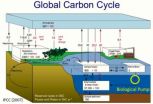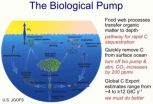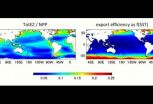(Press-News.org) (Santa Barbara, Calif.) — Nothing dies of old age in the ocean. Everything gets
eaten and all that remains of anything is waste. But that waste is pure gold to
oceanographer David Siegel, director of the Earth Research Institute at UC Santa
Barbara.
In a study of the ocean's role in the global carbon cycle, Siegel and his colleagues used those nuggets to their advantage. They incorporated the lifecycle of phytoplankton
and zooplankton — small, often microscopic animals at the bottom of the food chain —into a novel mechanistic model for assessing the global ocean carbon export. Their findings appear online in the journal Global Biogeochemical Cycles.
The researchers used satellite observations including determinations of net primary production (NPP) — the net production of organic matter from aqueous carbon dioxide (CO2) by phytoplankton — to drive their food-web-based model. The scientists
focused on the ocean's biological pump, which exports organic carbon from the euphotic zone — the well-lit, upper ocean — through sinking particulate matter, largely from zooplankton feces and aggregates of algae. Once these leave the euphotic zone, sinking into the ocean depths, the carbon can be sequestered for a season or for centuries.
"What we've done here is create the first step toward monitoring the strength and
efficiency of the biological pump using satellite observations," said Siegel, who is also a professor of marine science in UCSB's Department of Geography. "The approach is unique in that previous ways have been empirical without considering the dynamics of the ocean food web." The space/time patterns created by those empirical approaches are inconsistent with how oceanographers think the oceans should work, he noted.
Carbon is present in the atmosphere and is stored in soils, oceans and the Earth's
crust. Any movement of carbon between — or in the case of the ocean, within — these reservoirs is called a flux. According to the researchers, oceans are a central component in the global carbon cycle through their storage, transport and transformations of carbon
constituents.
"Quantifying this carbon flux is critical for predicting the atmosphere's response
to changing climates," Siegel said. "By analyzing the scattering signals that we got from satellite measurements of the ocean's color, we were able to develop techniques to calculate how much of the biomass occurs in very large or very small particles."
Their results predict a mean global carbon export flux of 6 petagrams (Pg) per year. Also known as a gigaton, a petagram is equal to one quadrillion (1015) grams. This is a huge amount, roughly equivalent to the annual global emissions of fossil fuel. At present, fossil fuel combustion represents a flux to the atmosphere of approximately 9 Pg
per year.
"It matters how big and small the plankton are, and it matters what the energy flows are in the food web," Siegel said. "This is so simple. It's really who eats whom but also having an idea of the biomasses and productivity of each. So we worked out these advanced ways of determining NPP, phytoplankton biomass and the size structure to formulate mass budgets, all derived from satellite data."
The researchers are taking their model one step further by planning a major field
program designed to better understand the states in which the biological pump operates. "Understanding the biological pump is critical," Siegel concluded. "We need to understand where carbon goes, how much of it goes into the organic matter, how that affects the air-sea exchanges of CO2 and what happens to fossil fuel we have emitted from our tailpipes."
INFORMATION:
Ocean food web is key in the global carbon cycle
2014-03-11
ELSE PRESS RELEASES FROM THIS DATE:
Lack of sleep, stress describe a mother's experience after child's ALL treatment
2014-03-11
"It's a whole new cancer world" and "I don't remember what it's like to have sleep" were the most common themes of mothers interviewed by University of Colorado Cancer Center researchers during the maintenance period after a child's treatment for acute lymphoblastic leukemia (ALL). Results of this qualitative study are published in a recent issue of the Journal of Pediatric Nursing. A second study, published today in the Journal of Pediatric Oncology Nursing, shows the quantitative differences between stress, anxiety and depression in these parents of chronically ill children ...
NREL examines solar policy pathways for states
2014-03-11
The Energy Department's National Renewable Energy Laboratory (NREL) has published a report that aligns solar policy and market success with state demographics. By organizing the 48 contiguous states into four peer groups based on shared non-policy characteristics, the NREL research team was able to contextualize the impact of various solar policies on photovoltaic (PV) installations.
"Although it is widely accepted that solar policies drive market development, there has not been a clear understanding of which policies work in which context," lead author Darlene Steward ...
Repeat ED visits for opioid overdose raise risk of hospitalization, respiratory failure
2014-03-11
Patients brought to hospital emergency departments (EDs) more than once in a year for treatment of opioid drug overdoses are more likely to be hospitalized for overdose and to need respiratory support with a mechanical ventilator. A study conducted by Massachusetts General Hospital (MGH) investigators also identified factors that increased the risk of subsequent overdoses requiring emergency department visits.
"To our knowledge this is the first study that has identified risk factors for repeat ED visits for opioid overdose," says Kohei Hasegawa, MD, MPH, MGH Department ...
New technique uses ATP as trigger for targeted anti-cancer drug delivery
2014-03-11
Biomedical engineering researchers have developed a new technique that uses adenosine-5'-triphosphate (ATP), the so-called "energy molecule," to trigger the release of anti-cancer drugs directly into cancer cells. Early laboratory tests show it increases the effectiveness of drugs targeting breast cancer. The technique was developed by researchers at North Carolina State University and the University of North Carolina at Chapel Hill.
"This is a proof of concept, but we've demonstrated there is now a new tool for introducing anti-cancer drugs directly into cancer cells ...
Empathy chimpanzees offer is key to understanding human engagement
2014-03-11
VIDEO:
First Rowena and then Liza watch videos of familiar chimpanzees yawning.
Click here for more information.
In their latest study about empathy, Yerkes National Primate Research Center researchers Matthew Campbell, PhD, and Frans de Waal, PhD, have shown chimpanzees exhibit flexibility in their empathy, just as humans do. These findings, which appear in the current issue of the Proceedings of the Royal Society B, may help explain the evolution of how and when humans engage ...
New gene for bipolar disorder discovered
2014-03-11
First on top of the world and then in the depths of despair – this is what the extreme mood changes for people with bipolar disorder are like. Under the direction of scientists from Bonn, Mannheim and Basel, an international collaboration of researchers discovered two new gene regions that are connected to the prevalent disease. In addition, they were able to confirm three additional suspect genes. In this unparalleled worldwide study, the scientists are utilizing unprecedented numbers of patients. The results are now being published in the renowned journal "Nature Communications."
Throughout ...
Dynamic stressing of a global system of faults results in rare seismic silence
2014-03-11
SAN FRANCISCO, March 11, 2014 -- In the global aftershock zone that followed the major April 2012 Indian Ocean earthquake, seismologists noticed an unusual pattern – a dynamic "stress shadow," or period of seismic silence when some faults near failure were temporarily rendered incapable of a large rupture.
The magnitude (M) 8.6 earthquake, a strike-slip event at intraoceanic tectonic plates, caused global seismic rates of M≥4.5 to spike for several days, even at distances tens of thousands of kilometers from the mainshock site. But beginning two weeks after the ...
Timid jumping spider uses ant as bodyguard
2014-03-11
A timid jumping spider uses the scent of ants as a secret weapon to save itself from becoming the somewhat soggy prey of the predatory spitting spider. The downside to this plan is that jumping spiders are also a favorite snack of its very own saviors. To overcome this additional hazard, the spider has made yet another plan in the form of an ant-proof nest, writes Ximena Nelson of the University of Canterbury in New Zealand and Robert Jackson of the University of Canterbury and the International Centre of Insect Physiology and Ecology in Kenya, in Springer's journal Behavioral ...
Magnet hospitals have higher quality of care, NYU researcher finds
2014-03-11
Magnet recognition is considered a leading source for measuring organizational success in nursing. Magnet hospitals show higher job satisfaction and lower odds of patient mortality than non-Magnet hospitals. However, only nine percent of American hospitals are recognized as Magnet. Currently, there is little research into the causes of the differences between Magnet and non-Magnet hospitals, research that could create an infrastructure for positive change in nurse and patient outcomes.
Now research from New York University College of Nursing (NYUCN) and the University ...
Some galaxies in the early universe grew up quickly
2014-03-11
Pasadena, CA— Some galaxies grew up in a hurry. Most of the galaxies that have been observed from the early days of the universe were young and actively forming stars. Now, an international team of astronomers, including Carnegie's Eric Persson and Andy Monson, have discovered galaxies that were already mature and massive in the early days. Fifteen mature galaxies were found at a record-breaking average distance of 12 billion light years, when the universe was just 1.6 billion years old. Their existence at such an early time raises new questions about what forced them to ...



